The nuclear baton of the US Navy (part 3)
After processing the materials obtained during the submarine nuclear test, made by 25 July 1946, as part of Operation Crossroads, the US Navy admirals came to the unequivocal conclusion that a very powerful anti-submarine weapon can be created on the basis of the nuclear charge. As it is known, water is a practically incompressible medium and, due to its high density, a blast wave propagating under water has a more destructive force than with an air explosion. It was experimentally established that with a charge power of around 20 kt, submarines that are in a submerged position within a radius of more than 1 km will be destroyed, or they will be damaged to prevent further performance of the combat mission. Thus, knowing the approximate location of the enemy's submarine, it could be sunk by a single nuclear depth bomb, or several submarines could be neutralized at once.
As is well known in the 50-s in the United States very much carried away with tactical nuclear weapons. In addition to operational-tactical, tactical and anti-aircraft missiles with nuclear warheads, even “atomic” recoilless artillery guns with a range of several kilometers were developed. Nevertheless, at the first stage, the American top military-political leadership opposed the admirals demanding the adoption of nuclear depth bomb bombs. According to politicians, such weapons had too low a threshold of application, and it was up to the commander of the carrier-based strike group, which could be thousands of kilometers from the American coast, to decide whether to use it or not. However, after the appearance of nuclear submarines with a high speed, all doubts were thrown back, and in April 1952 was authorized to develop such a bomb. Specialists from the Los Alamos Laboratory (nuclear charge) and the Naval Armaments Laboratory in Silver Springs, Maryland (the body and detonation equipment) began creating the first American nuclear depth bomb.
Upon completion of the product development, it was decided to conduct its “hot” tests. During the operation, Wigwam also determined the vulnerability of submarines in an underwater explosion. For this purpose, a tested nuclear explosive device with a capacity of more than 30 CT was suspended under a barge at a depth of 610 m. The explosion took place on 14 in May 1955 of the year at 20.00 local time in 800 km south-west of San Diego, California. More than 30 vessels and approximately 6800 people were involved in the operation. According to the memoirs of the American sailors who participated in the trials and were at a distance of more than 9 km, after the explosion, the sultan of water rose several hundred meters in height into the sky, and it sounded like a sledgehammer on the bottom of the ship.
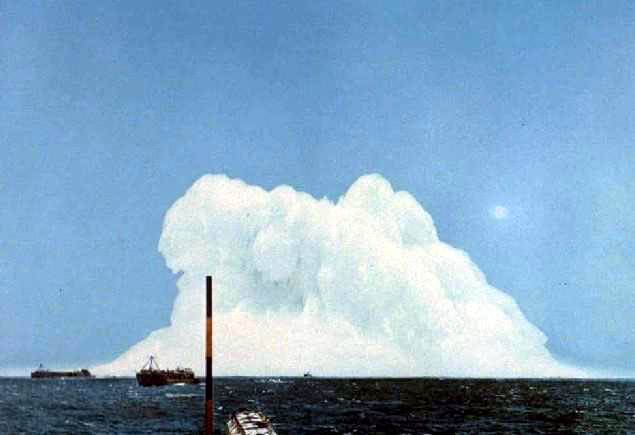
Under the three tugs, placed at different distances from the point of the explosion, unmanned underwater vehicles equipped with various sensors and telemetry equipment were suspended on cables.
After the combat characteristics of the depth bomb were confirmed, it was officially adopted. The production of the bomb is designated Mk. 90 "Betty" began in the summer of 1955, the total fleet received 225 products. In the anti-submarine aviation ammunition used the nuclear charge Mk.7 Mod.1 created on the basis of the W7 warhead widely used to create American tactical bombs, nuclear bombs, tactical and anti-aircraft missiles. The bomb weighing 1120 kg had a length of 3,1 m, diameter - 0,8 m and power 32 kt. The weight of the robust hull with hydrodynamic tail - 565 kg.
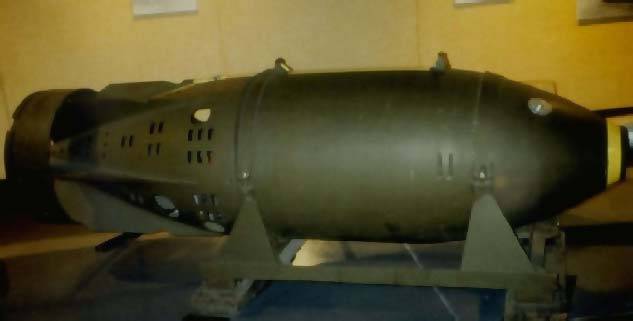
Since the nuclear depth bomb had a very significant area of destruction, it was impossible to use it safely from warships even when firing from a jet bomb bomb, and anti-aircraft aircraft became its carriers. In order that the aircraft after dropping from a height of less than 1 km could manage to leave the danger zone, the bomb was equipped with a parachute with a diameter of 5. m
To use the atomic bomb Mk.90 Betty, the 60 deck-based anti-submarine aircraft Grumman S2F-2 Tracker was built (after the X-NUMX of the S-1962C). This modification differed from other anti-submarine “Trackers” by an expanded bomb bay and an increased tail unit.
Deck antisubmarine aircraft S2F Tracker on the deck of the aircraft carrier USS Bennington (CV-20)
For the middle of the 50-x S2F Tracker was a very good patrol anti-submarine aircraft, with very sophisticated for that time radio-electronic equipment. The avionics had: a search radar, which at a distance of about 25 km could detect a submarine periscope, a set of sonar buoys, a gas analyzer to search for diesel-electric boats going under the snorkel and a magnetometer. The crew included two pilots and two avionics operators. Two 9-cylinder air-cooled engines Wright R-1820 82 WA horsepower 1525 allowed to accelerate the plane to 450 km / h, cruising speed - 250 km / h. Deck backwalker could be in the air for 9 hours. Typically, aircraft carrying a nuclear depth bomb operated in tandem with another “Tracker”, which conducted a search for a submarine using sonar buoys and a magnetometer.
Also the depth bomb Mk.90 Betty was part of the armament of the flying boat Martin P5M1 Marlin (after the 1962 of the year SP-5A). But, unlike the “Tracker,” a flying boat didn’t need a partner; she could search for submarines herself and strike at them.
By its anti-submarine capabilities, the Marilyn surpassed the deck Tracker. If necessary, the seaplane could get on the water and is in a given area for a very long time. For the crew of 11 people on board there were berths. The combat radius of the flying boat P5M1 exceeded 2600 km. Two star-shaped piston engines Wright R-3350-32WA Turbo-Compound horsepower 3450 X each, a seaplane was accelerated in horizontal flight to 404 km / h, cruising speed - 242 km / h. But unlike the deck anti-submarine aircraft, the century of the Marilyn was not long. In the middle of the 60's, it was considered obsolete, and in 1967, the US Navy finally replaced the anti-submarine patrol flying aircraft with the P-3 Orion coast-based aircraft with lower operating costs.
After adopting the atomic depth bomb Mk.90, it turned out that it is not suitable for everyday service on an aircraft carrier. Its mass and dimensions were excessive, which caused great difficulties when placed in the bomb bay. In addition, the power of the bomb was clearly excessive, and the reliability of the safety-executive mechanism was in doubt. As a result, just a couple of years after the adoption of the Mk.90, the admirals initiated work on a new depth bomb, which in its overall dimensions should be close to the existing ones. aviation deep bombs. After the appearance of more advanced models, in the early 60s Mk.90 was removed from service.
In 1958, the production of the atomic depth bomb Mk.101 Lulu began. Compared to the Mk.90, it was a much lighter and more compact nuclear weapon. Bomb length 2,29 m and diameter 0,46 m weighed 540 kg.
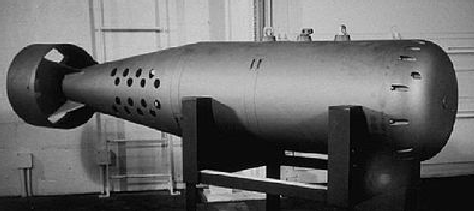
The mass and dimensions of the depth bomb Mk.101 allowed to significantly expand the list of its carriers. In addition to the "atomic" deck-based anti-submarine aircraft S2F-2 Tracker, the base patrol P-2 Neptune and P-3 Orion were based on the coast. In addition, about a half dozen Mk.101 were handed over to the British Navy as part of allied assistance. It is reliably known that the British hung American bombs on anti-submarine aircraft Avro Shackleton MR 2, which was created on the basis of the well-known World War II bomber Avro Lancaster. Archaic Shelkton’s service at Royal Dutch Navy continued until 1991, when it was finally replaced by the jet Hawker Siddeley Nimrod.
Unlike the Mk.90, the depth bomb Mk.101 was truly free-falling and dropped without a parachute. According to the method of application, it practically did not differ from ordinary depth charges. However, the pilots of the aircraft carrier still had to carry out bombing from a safe height.
The hot heart of the Lulu depth bomb was the W34 warhead. This plutonium-based nuclear implosion-type explosive device had a mass of 145 kg and energy release up to 11 kt. This warhead was specially designed for depth charges and torpedoes. In total, the fleet received about 600 bombs Mk.101 five serial modifications.
In 60-s, the naval aviation command of the United States as a whole organized the service and operational and combat characteristics of the Mk.101. In addition to the American territory, nuclear bombs of this type were placed in significant numbers abroad - at bases in Italy, Germany and Great Britain.
Operation of the Mk. 101 continued until 1971. The abandonment of this depth charges was primarily associated with the lack of safety of the safety-executive mechanism. After the forced or unintentional separation of the bomb from the carrier aircraft, it stood on a combat platoon, and the barometric fuse automatically detonated after it was submerged to a predetermined depth. Thus, in the event of an emergency discharge from an anti-submarine aircraft, an atomic explosion occurred, from which ships of their own could suffer fleet. In this regard, in the mid-60s, the deep bombs of Mk.101 began to be replaced by safer multipurpose thermonuclear bombs Mk.57 (B57).
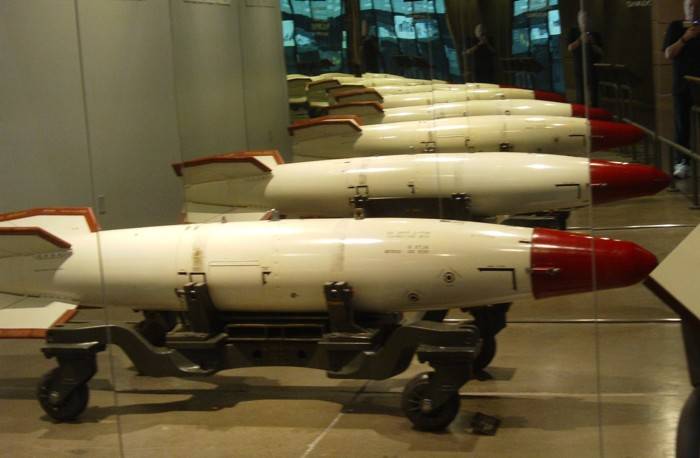
The tactical thermonuclear bomb Mk.57 was put into service in 1963 year. It was specially designed for tactical aircraft and was adapted to fly at supersonic speeds, for which the streamlined body had solid thermal insulation. After 1968, the bomb changed its designation to B57. In total, six serial variants with energy release from 5 to 20 CT are known. Some modifications had a Kevlar-nylon braking parachute with a diameter of 3,8 m. The depth bomb B57 Mod.2 was equipped with several degrees of protection and with a fuse activating a charge at a given depth. The power of a nuclear explosive device was 10 kt.
Not only the base Neptune and Orion patrols carried B57 Mod.2 depth charges, they were also used by Sikorsky SH-3 Sea King anti-amphibious helicopters and S-3 Viking deck planes.
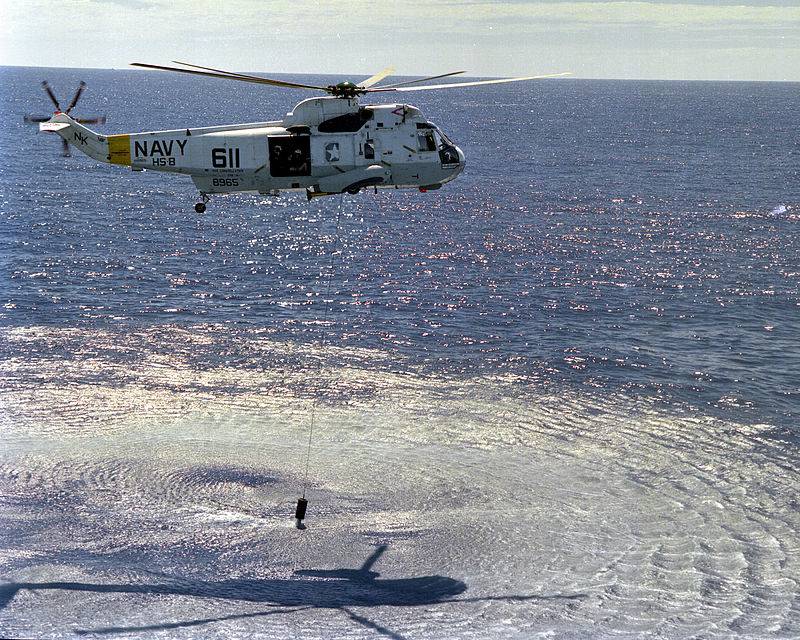
Anti-submarine helicopter SH-3 Sea King was commissioned in the 1961 year. An important advantage of this machine is the ability to sit on the water. In this case, the operator of the hydroacoustic station could conduct a search for submarines. In addition to the passive sonar station, there was an active sonar, a set of sonar buoys and a search radar. In addition to the two pilots, two workplaces were installed on board for search anti-submarine equipment operators.
Two turboshaft engines General Electric T58-GE-10 with a total power up to 3000 hp rotated the rotor with a diameter of 18,9 m. The helicopter with a maximum take-off weight of 9520 kg (normal in the PLO version - 8572 kg) was able to operate at a distance of up to 350 km from an aircraft carrier or coastal airfield. Maximum flight speed 267 km / h, cruising - 219 km / h. Combat load - up to 380 kg. Thus, "Sea King" could take one depth bomb B57 Mod.2, which weighed about 230 kg.
The SH-3H Sea King anti-submarine helicopters were in service with the US Navy until the second half of the 90-x, after which they were forced out by the Sikorsky SH-60 Sea Hawk. A few years before decommissioning the last Sea Kings in antisubmarine helicopter squadrons, the 57 atomic depth bomb was decommissioned. In 80, it was planned to replace it with a special universal modification with adjustable explosion power created on the basis of the thermo-nuclear B61. Depending on the tactical situation, the bomb could be used against both underwater and surface and ground targets. But due to the collapse of the Soviet Union and the collapse of the Russian submarine fleet, these plans were abandoned.
If the Sea King antisubmarine helicopters operated mainly in the near zone, the Lockheed S-3 Viking deck-based aircraft hunted submarines at a distance of up to 1300 km. In February 1974, the first S-3A entered the deck anti-submarine squadron. Within a short period of time, the jet Vikings ousted the piston Trakers, taking upon themselves, including the functions of the main carrier carrier of atomic depth charges. In addition, from the very beginning, the S-3A was the carrier of the B43 thermonuclear bomb with a mass of 944 kg, designed to attack surface or coastal targets. This bomb had several modifications with energy release from 70 kt to 1 Mt and could be used for solving tactical and strategic tasks.
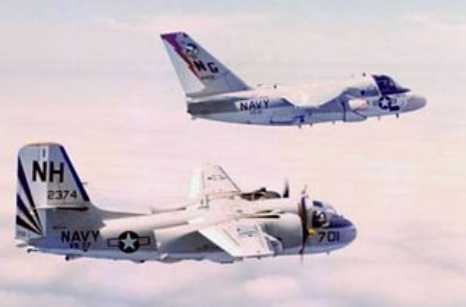
Thanks to the efficient General Electric TF34-GE-2 turbojet engines with 41,26 kN mounted on pylons under the wing, the S-3A anti-aircraft can develop 6100 km / h at 828 altitude. Cruising speed - 640 km / h. In the standard antisubmarine configuration, the take-off weight of the S-3A was 20 390 kg, the maximum - 23830 kg.
Since the maximum flight speed of the Viking was about twice as high as that of the Tracker, the reactive anti-submarine was better suited for tracking down atomic submarines, which, compared to diesel-electric submarines, had a much higher submarine speed. Given the current realities on the S-3A, they refused to use a gas analyzer, which is useless when searching for nuclear submarines. Anti-submarine capabilities "Viking" relative to "Tracker" increased many times. The search for submarines is mainly carried out with the help of discharged sonar buoys. Also, the anti-submarine equipment includes: a search radar, an electronic reconnaissance station, a magnetometer and an infrared scanning station. According to open sources, the search radar is able to detect the periscope of a submarine at a distance of 55 km with sea state up to 3 points.
Deck anti-submarine aircraft S-3A with extended magnetic anomaly sensor bar
In the tail of the aircraft is a telescopic telescopic rod magnetic sensor anomalies. Flight navigation system allows you to fly at any time of the day in difficult meteorological conditions. All avionics are combined into a combat information and control system controlled by the AN / AYK-10 computer. The crew of the aircraft is four people: two pilots and two operators of electronic systems. At the same time, the ability of the Viking to search for submarines is comparable to the much larger aircraft, the P-3 Orion, whose crew is an 11 man. This was achieved thanks to a high degree of automation of combat work and linking all the equipment into a single system.
Serial production of S-3A was conducted from 1974 to 1978 year. Total US Navy was transferred to 188 aircraft. The car turned out to be quite expensive; in 1974, one Viking cost the fleet $ 27 million, which, along with restrictions on deliveries abroad of modern anti-submarine equipment, prevented export deliveries. By order of the Navy of Germany, a modification of the S-3G with a simplified avionics was created. But because of the excessive cost of the anti-submarine aircraft, the Germans refused it.
Since 1987, 118 has brought the most "fresh" deck antishells up to the S-3В level. But the upgraded aircraft installed new high-speed electronics, widescreen information display monitors, improved jamming stations. There is also the possibility of using AGM-84 Harpoon anti-ship missiles. 16 "Vikings" were converted into ES-3A Shadow electronic reconnaissance aircraft.
In the second half of the 90's, Russian submarines became rare in the world's oceans, and the submarine threat to the US fleet was sharply reduced. In the new conditions in connection with the decommissioning of the Grumman A-6E Intruder deck bomber,
US Navy Command found it possible to convert most of the remaining S-3В into shock machines. At the same time, the B57 nuclear depth bomb was removed from service.
By reducing the crew to two people and dismantling the anti-submarine equipment, we improved the capabilities of the EW equipment, added additional heat trap shooting cassettes and dipole reflectors, expanded the range of strike weapons and increased the combat load. Up to 10 227-kg Мk.82 aerial bombs, two 454-kg Мk.83 or 908-kg Мk.84 could be placed in the internal compartment and on the nodes of the external hanger. The armament included air-surface missiles AGM-65 Maverick and AGM-84H / K SLAM-ER and blocks LAU 68A and LAU 10A / A with 70-mm and 127-mm HAP. In addition, it was possible to suspend thermonuclear bombs: B61-3, B61-4 and B61-11. With a bomb load 2220 kg combat range without refueling in the air is 853 km.
Vikings converted from PLO planes were used as deck bombers until January 2009. Aircraft S-3B attacked ground targets in Iraq and Yugoslavia. In addition to the bombs and guided missiles from the Vikings, more than 50 false targets ADM-141A / B TALD were launched with a range of 125-300 km.
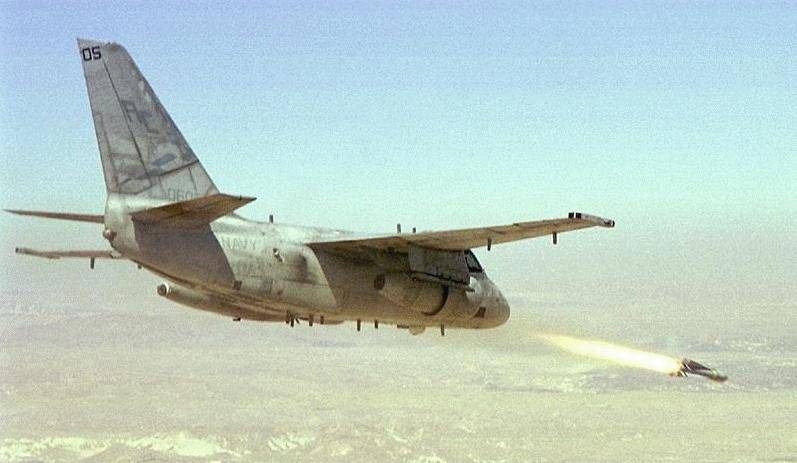
In January, the 2009 of the year, most of the deck S-3В were decommissioned, but individual machines are still used at the US Navy and NASA test centers. Currently in storage at Davis-Montana there is an 91 S-3В. In 2014, the command of the US Navy made a request for the return of 35 aircraft to service, which are planned to be used as tankers and for delivery of cargo to aircraft carriers. In addition, South Korea has shown interest in the overhauled and modernized Vikings.
In the 1957, the main submarine of the 626 Leninsky Komsomol project entered service in the USSR, followed by the Soviet Navy received an 1964 submarine, 12, before 627. On the basis of the nuclear torpedo boat of the 627 project, submarines of the 659 and 675 projects with cruise missiles were created, as well as the 658 (658М) avenue with ballistic missiles. Although the first Soviet submarine nuclear submarines had many drawbacks, the main one of which was high noise, they developed the speed of 26-30 nodes under water and had a maximum depth of diving to 300 m.
Combined anti-submarine maneuvers with the first US nuclear submarine, the USS Nautilus (SSN-571) and the USS Skate (SSN-578), demonstrated that after World War II destroyers Fletcher, Sumner and Giring could withstand them, but have there are few chances against more high-speed Skipjack boats, the speed of which reached 30 knots. Given that the stormy weather in the North Atlantic was quite common, the conceived anti-submarine ships were unable to go at full speed and move closer to the submarine the distance of the use of depth charges and anti-submarine torpedoes. Thus, to increase the anti-submarine capabilities of existing and future US Navy warships, a new weapon was needed that could nullify the superiority of nuclear submarines in speed and autonomy. This was especially true for ships of relatively small displacement involved in escort convoys.
Almost simultaneously with the start of mass construction in the USSR of nuclear submarines in the United States began to test the anti-submarine missile system RUR-5 ASROC (eng. Anti-Submarine Rocket - Anti-submarine missile). The rocket was created by Honeywell International with the participation of experts from the Testing Station of the US Navy Main Armaments Directorate in China Lake. Initially, the anti-submarine missile launch range was limited to the detection range of the AN / SQS-23 sonar and did not exceed 9 km. However, after the more advanced sonar stations AN / SQS-26 and AN / SQS-35 were put into service, it became possible to get target designation from onboard anti-submarine aircraft and helicopters, and in later versions it reached 19 km.
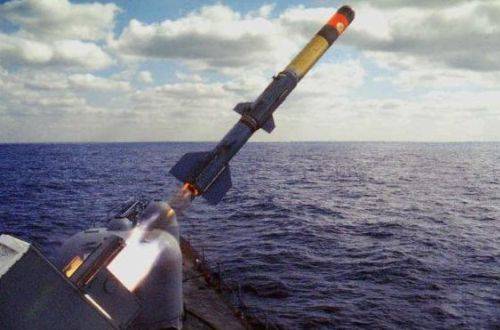
The 487 kg rocket had a length of 4,2 and a diameter of 420 mm. For launch, initially used eight charging launchers Mk.16 and Mk.112 with the possibility of mechanized recharging on board the ship. So on board the destroyer of the type "Spryuens" a total of 24 anti-submarine missiles. Also, on some ships, PLUR ASROK was launched from girder launchers Mk.26 and Mk.10, which were also used for the RIM-2 Terrier and RIM-67 Standard anti-aircraft missiles and the Mk.41 universal launch systems.
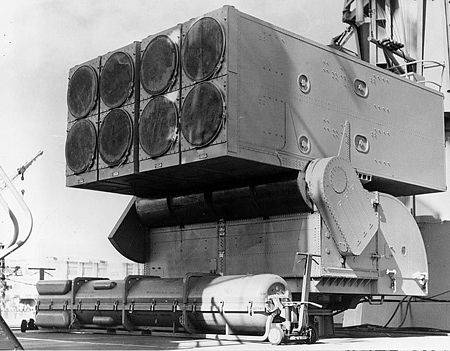
To control the shooting of the ASROC complex, the Mk.111 system is used, which receives data from the shipboard GAS or an external target designation source. The calculating device Mk.111 provides calculation of the flight path of the rocket taking into account the current coordinates, the speed and speed of the carrier ship, the direction and speed of the wind, air density, and also generates initial data that is automatically entered into the onboard control system of the rocket. After launching from the carrier ship, the rocket flies along a ballistic trajectory. The firing range is determined by the moment of separation of the solid propellant propulsion engine. The separation time is pre-entered into the timer before starting. After disconnecting the engine, the warhead with the transitional device continues to fly to the target. When used as a warhead of an electric self-guided torpedo Mk.44, braking of the warhead in this part of the trajectory is performed by a braking parachute. After diving to a predetermined depth, the propulsion system is launched, and the torpedo searches for a target, moving in a circle. If the target on the first lap is not detected, it continues searching at several depth levels, plunging according to a predetermined program. The self-guided acoustic torpedo Mk.44 had a rather high probability of hitting the target, but it could not attack the boats moving at a speed of more than 22 nodes. In this regard, a missile was introduced into the ASROK anti-submarine complex, which used the Mk.17 depth bomb with a W44 nuclear warhead of 10 kt as a warhead. The W44 warhead weighed 77 kg, had a length of 64 cm and a diameter of 34,9 cm. In total, the US Department of Energy handed over XX WUMN to WNNX XB.
The adoption of the RUR-5a Mod.5 rocket with the Mk.17 nuclear depth bomb was preceded by full-scale tests under the code name Swordfish (Swordfish). 11 May 1962 anti-submarine missile with a nuclear warhead was launched from the board of the destroyer USS Agerholm (DD-826) of the type "Giring". An underwater nuclear explosion occurred at a depth of 198 m in 4 km from the destroyer. In a number of sources it is mentioned that in addition to the Swordfish test in 1962, another test of the nuclear depth bomb Mk.17 was carried out as part of Operation Dominic. However, this is not officially confirmed.
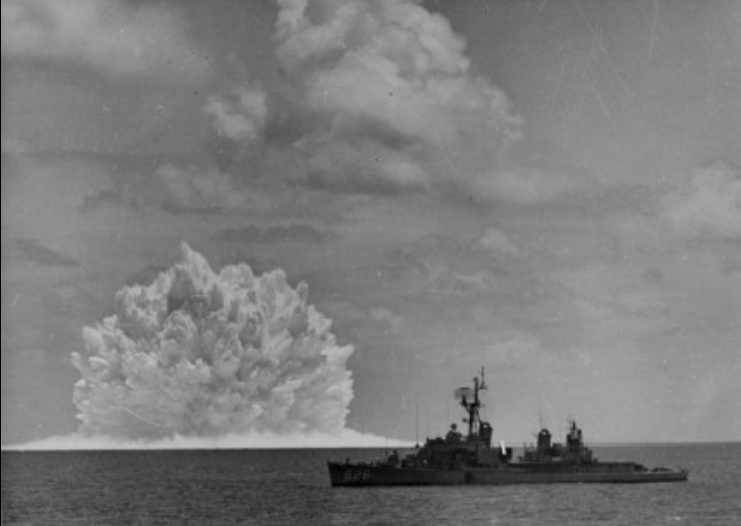
Anti-submarine complex "ASROK" was very widespread, both in the US Navy and the US allies. It was installed both on cruisers and destroyers built during the Second World War, as well as on ships of post-war construction: frigates of the type “Garcia” and “Knox”, destroyers of the type “Spruyens” and “Charles F. Adams”.
According to US data, the PLUR RUR-5a Mod.5 operation with nuclear warhead continued until the 1989 year. After which they were decommissioned and disposed of. On modern American ships, the anti-submarine complex RUR-5 ASROC has been replaced by the RUM-139 VL-ASROC created on its base. The VL-ASROC complex, which entered service in 1993, uses upgraded missiles with a launch range of up to 22 km, carrying anti-submarine self-guided torpedoes Mk.46 or Mk.50 with conventional warhead.
The adoption of the PLUR RUR-5 ASROC has seriously increased the antisubmarine potential of American cruisers, destroyers and frigates. And also by reducing the time interval since the discovery of the submarine to its shelling significantly increase the likelihood of defeat. Now, for the attack, the submarine discovered by the GAS of a ship carrying anti-submarine missiles or passive sonar buoys dropped by aviation did not need to approach the “distance of the pistol shot” with the place where the boat was in the submerged state. It is quite natural that American submariners also expressed a desire to obtain weapons with similar characteristics. At the same time, the dimensions of the anti-submarine missile launched from a submerged position should have allowed it to be shot from standard 533-mm torpedo tubes.
The development of such weapons began Goodyear Aerospace Corporation in 1958, the tests ended in 1964 year. According to the American admirals responsible for the development and testing of missile systems intended for armament of submarines, the creation of an anti-submarine missile with an underwater launch was even more difficult than the development and refinement of the UGM-27 Polaris SLBM.
In 1965, the US Navy introduced a UUM-44 Subroc anti-submarine guided missile into submarine armament. The missile was intended to fight enemy submarines at a long distance, when the distance to the target was too great, or the enemy's boat moved too fast, and it was not possible to use torpedoes.
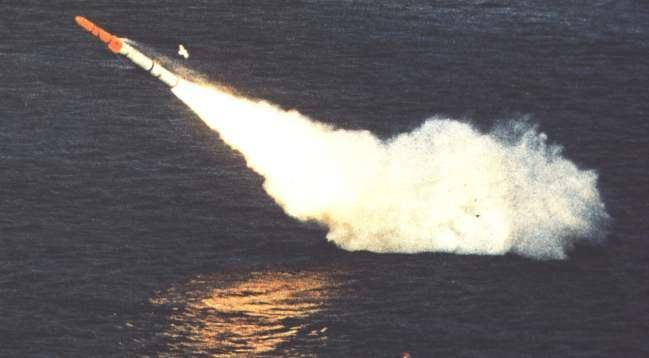
In preparation for the combat use of the PLUR UUM-44 Subroc, the target data obtained using the sonar system was processed by an automated command and control system, and then entered into the autopilot of the rocket. The PLUR control on the active leg of the flight was carried out by four gas deflectors using the signals of the inertial navigation subsystem.
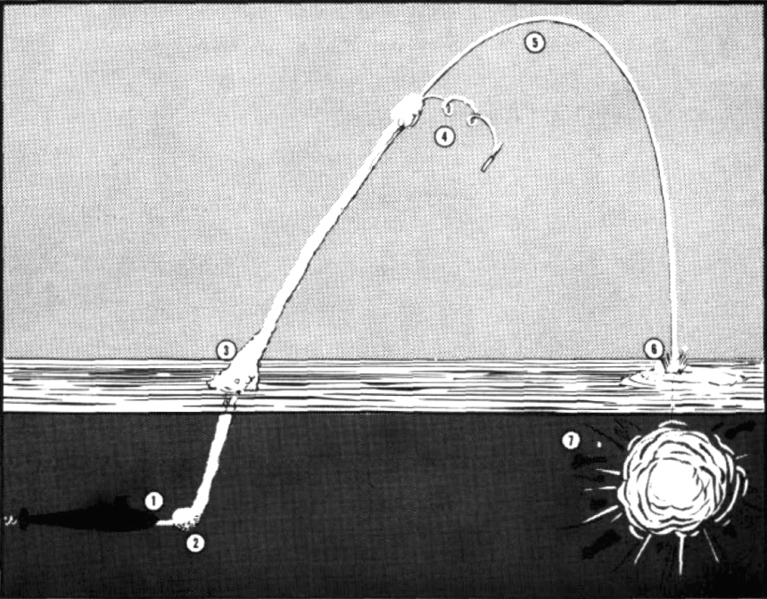
The launch of a solid fuel engine was made after exiting the torpedo tube, at a safe distance from the boat. After exiting the water, the rocket accelerated to supersonic speed. At the calculated point of the trajectory, a braking jet engine was activated, which ensured the separation of the nuclear depth charge bomb from the rocket. The warhead with the “special warhead” W55 had aerodynamic stabilizers, and after separation from the rocket body flew along a ballistic trajectory. After being immersed in water, it was activated at a predetermined depth.
The mass of the missile in a combat position slightly exceeded 1850 kg, length - 6,7 m, diameter of the propulsion system - 531 mm. The late version of the missile put into service in the 80-s could hit targets at a distance of up to 55 km, which, in combination with YaBCh, made it possible to fight not only with submarines, but also to strike at surface squadrons. The nuclear warhead of the W55 with a length of 990 mm and a diameter of 350 mm weighed 213 kg and had a power of 1-5 kt in TNT.
PLUR "SUBROK" after the adoption of weapons went through several stages of modernization aimed at improving the reliability, accuracy and firing range. These missiles with nuclear depth bombs during the Cold War were part of the armament of most US nuclear submarines. The decommissioning of UUM-44 Subroc occurred in the 1990 year. The submarine-launched anti-submarine missiles with the submarine launch should have replaced the UUM-125 Sea Lance rocket system. Its development from 1982 year led the corporation Boeing. However, the process of creating a new PLUR was greatly delayed, and in the middle of the 90-s, due to a sharp reduction in the Russian submarine fleet, the program was curtailed.
In addition to the SUBROK missiles, the armament of American atomic submarines contained anti-submarine torpedoes with a nuclear warhead Mk. 45 ASTOR (English Anti-Submarine Torpedo - Anti-submarine torpedo). Work on the "atomic" torpedo was carried out from 1960 to 1964 year. The first batch of Mk. 45 entered the naval arsenals at the beginning of 1965. Total 600 torpedoes were produced around the year.
Torpedo Mk. The 45 had a caliber of 483-mm, a length of 5,77 m and a mass of 1090 kg. It was completed only with a nuclear warhead of W34 with 11 CT power - the same as the depth bomb Mk.101 Lulu. The Astor anti-submarine torpedo had no homing, after exiting the torpedo tube all its maneuvers were controlled by the guidance operator from the submarine. Control commands were transmitted via cable, the nuclear warhead was also blown up remotely. The maximum range of the torpedo was 13 km and was limited by the length of the cable. In addition, after the launch of the remote-controlled torpedo, the American submarine was constrained to maneuver, as it was necessary to take into account the probability of a cable break.
When creating an atomic Mk. 45 used the hull and electric propulsion of the homing anti-submarine torpedo Mk. 37. Given that Mk. 45 was heavier than its maximum travel speed not exceeding 25 knots, which could not be enough for targeting the high-speed Soviet submarine.
I must say that the American submariners were very wary of these weapons. In view of the high enough power of the nuclear warhead W34 when firing torpedoes Mk. 45 there was a high probability to put its own boat on the bottom. Among the American submariners there was even a grim joke that the probability of sinking the boat with a torpedo was equal to 2, since both the enemy boat and its own were destroyed. In 1976, the Mk. 45 was removed from service, replacing the homing torpedo Mk. 48 with the usual warhead.
To be continued ...
Based on:
https://feldgrau.info/waffen/13938-atomnaya-glubinnaya-bomba
http://www.dogswar.ru/boepripasy/snariady-rakety/6972-atomnaia-glybinnaia-.html
https://www.revolvy.com/page/B57-nuclear-bomb
http://www.airwar.ru/enc/sea/s3.html
http://pentagonus.ru/publ/protivolodochnye_raketnye_kompleksy/31-1-0-1394
https://www.businessinsider.com/the-6-best-anti-submarine-weapons-2015-10
http://www.seaforces.org/wpnsys/SURFACE/RUR-5-ASROC.htm
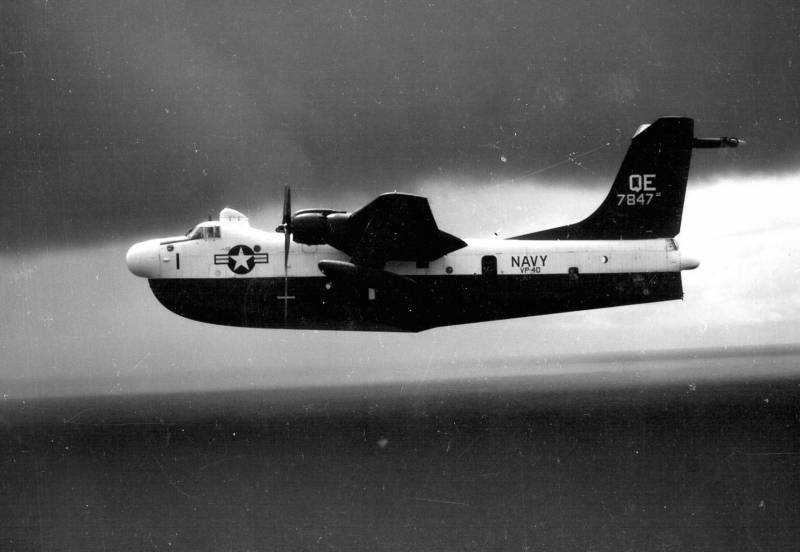
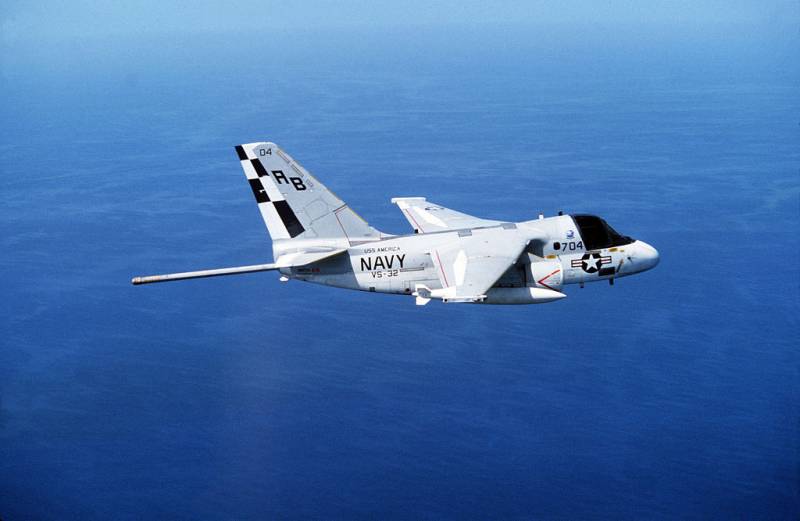
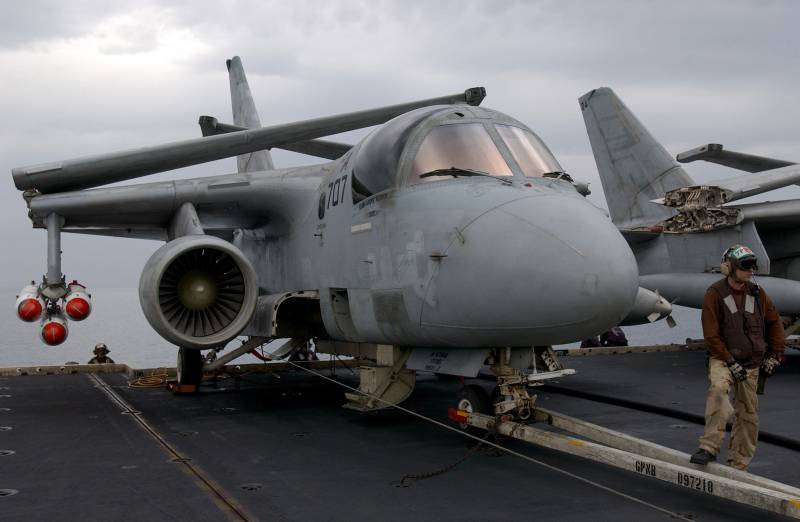
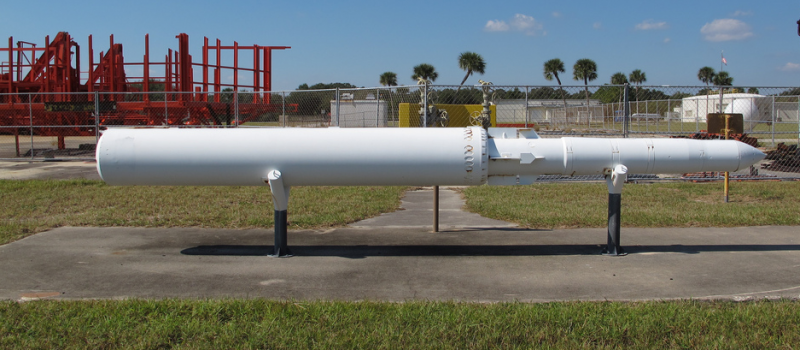
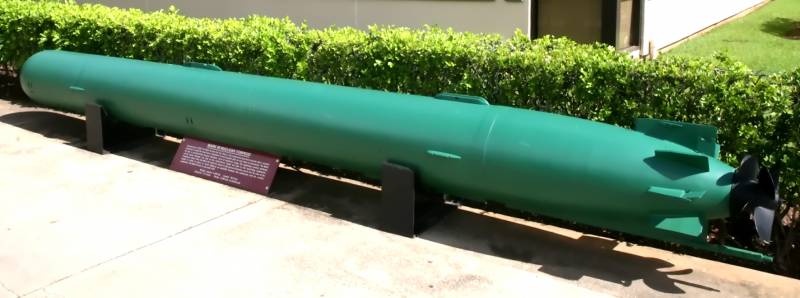
Information